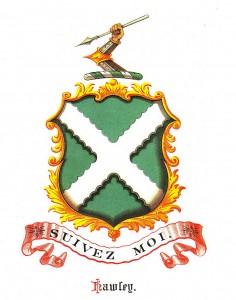“The second meeting of the Executive Committee took place September 12, 1923 at the home of Mr Alan R. Hawley, New York City, nine members were present. The Constitution and By Laws were read and accepted. Designs for the official emblem of the Society were submitted by Mr. William C. Hawley of Bridgeport. It was voted that the emblem should contain the entire coat of arms; and later voted that the Society order one hundred emblems of Mr William C. Hawley to be sold for one dollar each or one dollar and ten cents if mailed to the purchaser.” Source: The Society of the Hawley Family Archives
A coat of arms is a unique heraldic design on a shield or escutcheon or on a surcoat or tabard used to cover and protect armor and to identify the wearer. Thus the term is often stated as “coat-armor”, because it was anciently displayed on the front of a coat of cloth. The coat of arms on an escutcheon forms the central element of the full heraldic achievement which consists of shield, supporters, crest and motto. The design is a symbol unique to an individual person, and to his family, corporation, or state. Such displays are commonly called armorial bearings, armorial devices, heraldic devices, or simply armorials or arms.
Historically, armorial bearings were first used by feudal lords and knights in the mid-12th century on battlefields as a way to identify allied from enemy soldiers. As the uses for heraldic designs expanded, other social classes who never would march in battle began to assume arms for themselves. Initially, those closest to the lords and knights adopted arms, such as persons employed as squires that would be in common contact with the armorial devices. Then priests and other ecclesiastical dignities adopted coats of arms, usually to be used as seals and other such insignia, and then towns and cities to likewise seal and authenticate documents. Eventually by the mid-13th century, peasants, commoners and burghers were adopting heraldic devices. The widespread assumption of arms led some states to regulate heraldry within their borders. However, in most of continental Europe, citizens freely adopted armorial bearings.
In the United Kingdom, the College of Arms is the official repository of the coats of arms and pedigrees of English, Welsh, Northern Irish and Commonwealth families and their descendants. Its records also include official copies of the records of Ulster King of Arms the originals of which remain in Dublin.
The officers of the College, known as heralds, specialize in genealogical and heraldic work for their respective clients. Coats of arms have been and still are granted by Letters Patent from the senior heralds, the Kings of Arms. A right to arms can only be established by the registration in the official records of the College of Arms of a pedigree showing direct male line descent from an ancestor already appearing therein as entitled to arms, or by making application through the College of Arms for a grant of arms. Grants are made to corporations as well as to individuals.

There is no such thing as a ‘coat of arms for a surname’. Many people of the same surname will often be entitled to completely different coats of arms, and many of that surname will be entitled to no coat of arms. Coats of arms belong to individuals. For any person to have a right to a coat of arms they must either have had it granted to them or be descended in the legitimate male line from a person to whom arms were granted or confirmed in the past.
It is a popular misconception that the word ‘crest’ describes a whole coat of arms or any heraldic device. It does not. A crest is a specific part of a full achievement of arms: the three-dimensional object placed on top of the helm.
Excerpted from http://www.college-of-arms.gov.uk
The Hawley Society acknowledges its use of the Coat of Arms is only as an emblem. This version was included by Elias Sill Hawley graphicly in THE HAWLEY RECORD. It is properly the Coat of Arms of the Baronet Hawleys of Leybourne Grange, Kent. As noted in the opening quote, it was selected by the original Executive Committee of the Society in 1923.
This coat of arms was granted to the Hawley Baronets. The Hawley Baronetcy, of Leybourne Grange in the County of Kent, was created in the Baronetage of Great Britain on 14 March 1795 for Henry Hawley. The third Baronet who served as High Sheriff of Kent in 1844 was succeeded by his brother. The fifth Baronet was the nephew of both the 3rd and 4th Baronets, and the son of Rev Henry Charles Hawley, Rector of Leybourne. The sixth Baronet died without issue and was succeeded by his nephew who was High Sheriff of Lincolnshire in 1962. The ninth and present Baronet, who does not use his title, has not attempted to prove his succession and is therefore not on the Official Roll of the Baronetage, with the baronetcy considered dormant since 1988.


